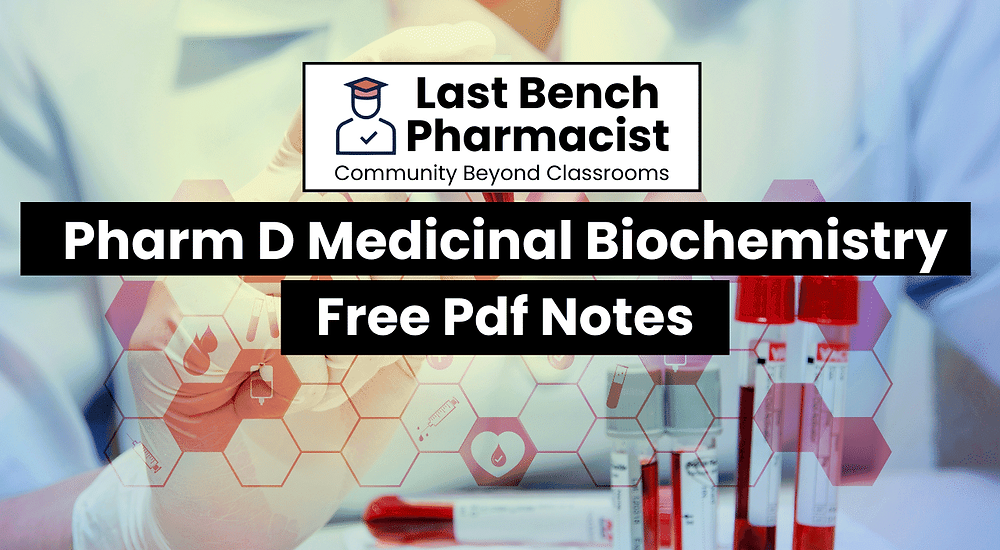



#pharmdnotes #pharmd1styearnotes #pharmdmedicinalbiochemsitrynotes
Ever wondered how medications work their magic on a molecular level? These Pharm D Medicinal Biochemistry PDF Notes throws open the doors to the captivating world of Pharm D Medicinal Biochemistry. We’ll embark on a journey exploring the intricate dance between biomolecules, drugs, and cellular processes. Delve into the fascinating relationship between a drug’s chemical structure and its biological activity, and unlock the secrets of how medications interact with the body’s machinery. These Pharm D Medicinal Biochemistry PDF Notes will equip you with the foundational knowledge to appreciate the intricate dance of life and the remarkable science behind the development of effective and targeted therapies.
Applied biochemistry deals with complete understanding of the molecular level of the chemical process associated with living cells.Clinical chemistry deals with the study of chemical aspects of human life in health and illness and the application of chemical laboratory methods to diagnosis, control of treatment, and prevention of diseases.
Upon completion of the course, the student shall be able to understand:-
Understand the catalytic activity of enzymes and importance of isoenzymes in diagnosis of diseases;
Know the metabolic process of biomolecules in health and illness (metabolic disorders);
Understand the genetic organization of mammalian genome; protein synthesis; replication; mutation and repair mechanism;
Know the biochemical principles of organ function tests of kidney, liver and endocrine gland;
Do the qualitative analysis and determination of biomolecules in the body fluids.
Introduction to biochemistry: Cell and its biochemical organization, transport process across the cell membranes. Energy rich compounds; ATP, Cyclic AMP and their biological significance.
Enzymes: Definition; Nomenclature; IUB classification; Factor affecting enzyme activity; Enzyme action; enzyme inhibition. Isoenzymes and their therapeutic and diagnostic applications; Coenzymes and their biochemical role and deficiency diseases.
Carbohydrate metabolism: Glycolysis, Citric acid cycle (TCA cycle), HMP shunt, Glycogenolysis, gluconeogenesis, glycogenesis. Metabolic disorders of carbohydrate metabolism (diabetes mellitus and glycogen storage diseases); Glucose, Galactose tolerance test and their significance; hormonal regulation of carbohydrate metabolism.
Lipid metabolism: Oxidation of saturated (-oxidation); Ketogenesis and ketolysis; biosynthesis of fatty acids, lipids; metabolism of cholesterol; Hormonal regulation of lipid metabolism. Defective metabolism of lipids (Atheroslerosis, fatty liver, hypercholesterolmiea).
Biological oxidation: Coenzyme system involved in Biological oxidation. Electron transport chain (its mechanism in energy capture; regulation and inhibition); Uncouplers of ETC; Oxidative phosphorylation;
Protein and amino acid metabolism: protein turn over; nitrogen balance; Catabolism of Amino acids (Transamination, deamination & decarboxylation). Urea cycle and its metabolic disorders; production of bile pigments; hyperbilirubinemia, porphoria, jaundice. Metabolic disorder of Amino acids.
Nucleic acid metabolism: Metabolism of purine and pyrimidine nucleotides; Protein synthesis; Genetic code; inhibition of protein synthesis; mutation and repair mechanism; DNA replication (semiconservative /onion peel models) and DNA repair mechanism
Introduction to clinical chemistry: Cell; composition; malfunction; Roll of the clinical chemistry laboratory.
The kidney function tests: Role of kidney; Laboratory tests for normal function includes
a) Urine analysis (macroscopic and physical examination, quantitative and semiquantitative tests.)
b) Test for NPN constituents. (Creatinine /urea clearance, determination of blood and urine creatinine, urea and uric acid)
c) Urine concentration test
d) Urinary tract calculi. (stones)
Liver function tests: Physiological role of liver, metabolic, storage, excretory, protective, circulatory functions and function in blood coagulation.
a) Test for hepatic dysfunction-Bile pigments metabolism.
b) Test for hepatic function test- Serum bilirubin, urine bilirubin, and urine urobilinogen.
c) Dye tests of excretory function.
d) Tests based upon abnormalities of serum proteins.
Lipid profile tests: Lipoproteins, composition, functions. Determination of serum lipids, total cholesterol, HDL cholesterol, LDL cholesterol and triglycerides.
Immunochemical techniques for determination of hormone levels and protein levels in serum for endocrine diseases and infectious diseases.
Radio immuno assay (RIA) and Enzyme Linked Immuno Sorbent Assay (ELISA)
Electrolytes: Body water, compartments, water balance, and electrolyte distrubution. Determination of sodium, calcium potassium, chlorides, bicarbonates in the body fluids.